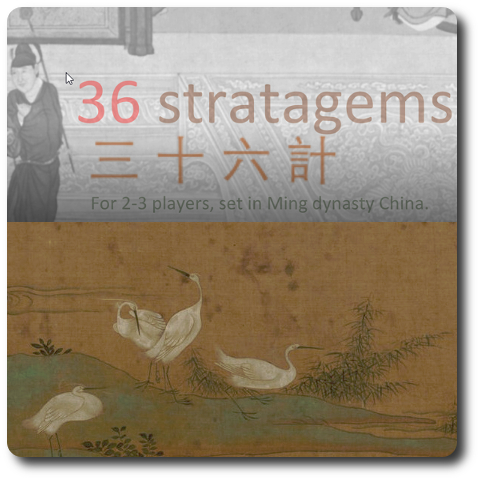
The Basics:
- For ages 12 and up
- For 2 to 3 players
- Approximately 180 minutes to complete
Geek Skills:
- Active Listening & Communication
- Counting & Math
- Logical & Critical Decision Making
- Reading
- Strategy & Tactics
- Risk vs. Reward
- Hand/Resource Management
- Worker Placement & Area Control
Learning Curve:
- Child – Moderate
- Adult – Easy
Theme & Narrative:
- To rule the land you must rule the people
Endorsements:
- Gamer Geek approved!
- Parent Geek mixed!
- Child Geek rejected!
Overview
The Ming Dynasty (1368–1644) brought about great social stability and governmental order. In short, peace and growth, but at a price. There are always forces at work that impede progress and reform. As a political leader, your ambition to rule will conflict with others. Something worth ruling is worth fighting for.
36 Stratagems, designed by Matthew Fawbert and self-published via the Game Crafter, is comprised of 1 game board, 6 standard six-sided dice, an assortment of chits (that represent the player’s units, neutral parties, rebellions, scouts, and the Emperor’s army), 3 Player mats, an assortment of Coin markers (representing the values of 1, 2, and 5), Season markers, 10 Capital cards, 32 Prefecture cards, 14 Tribute cards, 14 Action cards, and 36 Stratagem cards. The game board is made of thick cardboard, as are the chits and markers. The cards are as thick and as durable as your standard playing card.
From Chaos, Order
To set up the game, first place the game board in the middle of the playing area. The game board represents the area and territory that was part of the Ming Dynasty in China. The game board has a map (1), a Season track (2), a Tribute track (3), a Neutral Armies track (4), and a Victory track (5). In addition, the map has a key (6) that helps identify capitals, cities, towns, agricultural colonies, markets, different types of roads, sea routes, temples, the Great Wall, and regions.

Second, organize the chits into separate piles. These will be called “pools” for each of the chit types. The fastest and most effective way to get this done is to do it by color using the backs of the chits to assist. Do the same for the markers.
Third, take the Capital cards and remove “Karakorum”, “Lhasa”, and “Hanseong”. Shuffle the removed cards and have each player draw 1 Capital card at random. The player’s drawn Capital card indicates their starting capital on the game board. Capital cards reveal the player’s starting units (identified by the chits), as well.
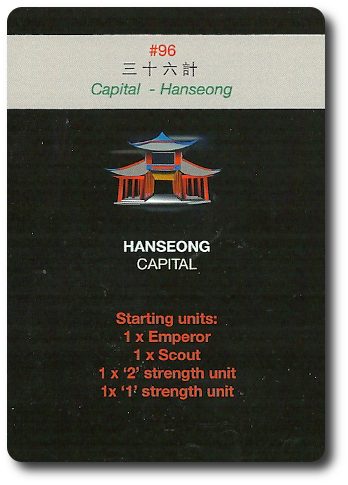
The units are collected now and placed face-down on the player’s Player mat. which represents the player’s “State of the Nation”. They should remain face-down (unless in combat) and secret at all times, but the owning player is welcome to look at them whenever they like. In addition to the chits, give each player 3 Coin markers.
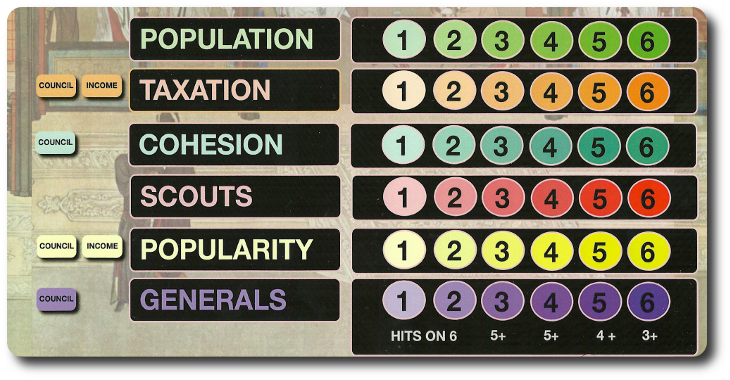
- Population = the total number of capitals controlled by the player
- Taxation = income, which impacts popularity
- Cohesion = political clout and support
- Scouts = spies and agents
- Popularity = overall love of the people that will save you from a rebellion
- Generals = military strength
Fourth, set the Season marker to 1, the Neutral Hits marker to “6 only”, and the Neutral Armies marker on an empty capital space (with the “2” showing).
Fifth, all players add a chit to the “3” space on the Victory track and the “0” space on the Tribute track.
Sixth, set up the remaining card decks by shuffling them together by type and placing them face-down next to the game board.
- Action cards are played during the Action phase of the game. These cards give the player a special move they can take.
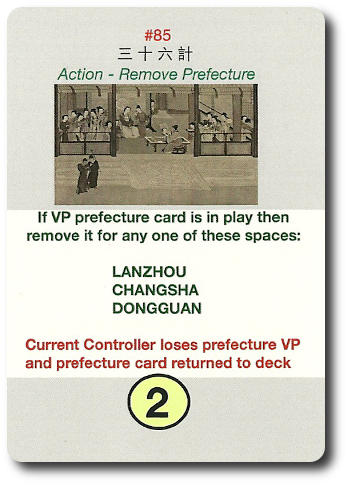
- Tribute cards are only given to players who have accumulated enough tribute during the game. Tribute cards give the player a bonus.
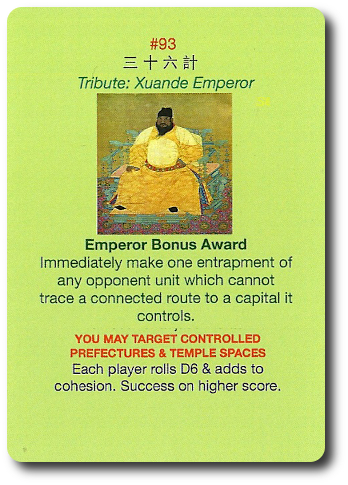
- Prefecture cards give the player victory points.
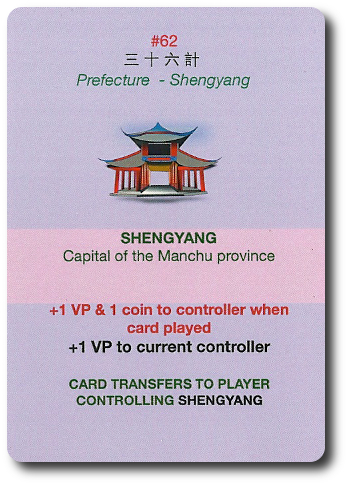
- Stratagem cards are like the Action cards, but are more abundant and useful in most encounters.
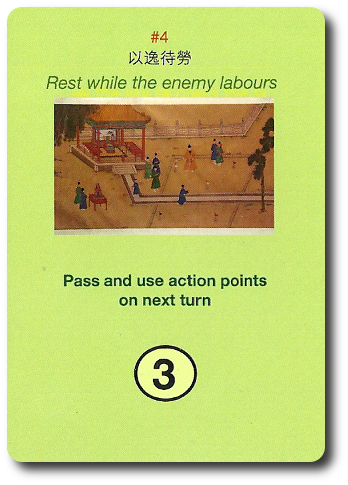
That’s it for set up. Let’s get to the game.
The Emperor’s Domain
36 Stratagems is not an overly complicated game, but it does give the player a lot of freedom. This means it’s very difficult for me to cover every aspect of the game play. Instead, I will summarize the game here to put emphasis on what you can expect without bogging you down with the details.
The game is played in 9 rounds. Each round is referred to as a “Season”. Each Season is further divided into 8 phases. The phases are summarized here.
Phase 1: Deal Cards and Determine Turn Order
At the start of every Season, each player is dealt 4 Stratagem cards, 1 Action card, and 1 Prefecture card. These are added to any other cards the player may have in their hand.
Then each player rolls 1 die. The player who rolled the highest number goes first with the turn order sequence following the next highest number rolled and so on.
Phase 2: Take Action
Players now play 1 card at a time in turn order sequence, resolving the card as soon as it’s played. A player can pass if they so choose. The Action phase does not end until all players have played their cards or all players have passed.
In the event that combat occurs due to the proximity of enemy unit chits, dice are rolled to determine the outcome. Players can organize their unit chits so they flank enemies.
Each player can only keep 1 card of their choice for the next season if they still have 2 or more remaining cards they have not played during this phase.
Phase 3: Council
The player must now make a choice. They can increase their Cohesion, Taxation, Popularity, or Generals by “+1”. Only one of these values may be increased at this time.
Phase 4: Rebellion
Each player now rolls to determine if their capitals are engulfed by rebellion with people running in the streets and general chaos ensuing. If the player has more than 1 capital, they can elect to save one from possible problems. The others must be resolved by rolling dice and seeing if the rolled value is below the rebellion criteria.
Phase 5: Income
The players now receive income through taxation multiplying their Population value by the Taxation value, then adding +2 Coins. However, rebellion will decrease a player’s possible income. The rebellions in the capitals will be squashed before the next Season, but not before the money is collected.
Phase 6: Winter
Winter is only used in the Advanced game and puts the hurt on the population and food supply. A harsh winter also causes units to retreat to the warmth behind city walls, clearing many of the roads.
Phase 7: Attrition
Players must now pay to keep their little empire growing. If the player cannot pay, they reduce their total number of units until they can afford what they have.
Phase 8: Deployment
Now the players can purchase new units, deploy them, and re-deploy others.
Things Not Covered
There are a lot of other rules we did not cover, mostly due to time and lack of context that would make the rule seem very confusing. Just to name a few is the ability to split groups of units to better cover territory, piracy on the seas, and stealing from other opponents. There are also rules that cover plagues and sanitation, meaning players have to consider how they can keep their growing population and empire safe and healthy. In short, there’s a lot more “little things” that make a larger whole in the game that are worth looking into.
Game Variants
The game described above is referred to as the “Basic” game, although there is nothing basic about it. Additional levels of complexity can be added to the game as needed. Several are summarized here.
More Capitals
The Basic game has a set number of Capital cards. Add more as needed, but be aware that it’s possible that players could start the game right next to each other.
Winter is Coming
As already mentioned above, the winter season can or cannot be used by the players. Using it makes the game much more complicated due to the need to compensate for lost ground and units.
To learn more about 36 Stratagems, visit the game’s web page on the Game Crafter.
Final Word
 Only the most skilled of our Child Geeks enjoyed 36 Stratagems. While none of our Child Geeks had a great deal of difficulty learning the basics, the different cards that are dealt out each round and the ongoing maintenance of their empire was just too much for them to handle. According to one Child Geek, “There’s just too much going on here. I’m losing track of what I need to do.” Another Child Geek said, “I liked the first 2 rounds of the game, but everything after that has been kind of boring and its hard to keep track of what is happening.” The game does allow players to do a great deal and keeping track of what your opponents are doing is a game in and of itself with its own challenges. But the older Child Geeks really enjoyed it. According to one Child Geek, “The game length is a bit long, but the game play is a lot of fun. I’d play this again.” When all the votes were in, only the most skilled and elite of our Child Geeks voted to approve 36 Stratagems, which was a very small minority to the majority of Child Geeks who voted to reject it.
Only the most skilled of our Child Geeks enjoyed 36 Stratagems. While none of our Child Geeks had a great deal of difficulty learning the basics, the different cards that are dealt out each round and the ongoing maintenance of their empire was just too much for them to handle. According to one Child Geek, “There’s just too much going on here. I’m losing track of what I need to do.” Another Child Geek said, “I liked the first 2 rounds of the game, but everything after that has been kind of boring and its hard to keep track of what is happening.” The game does allow players to do a great deal and keeping track of what your opponents are doing is a game in and of itself with its own challenges. But the older Child Geeks really enjoyed it. According to one Child Geek, “The game length is a bit long, but the game play is a lot of fun. I’d play this again.” When all the votes were in, only the most skilled and elite of our Child Geeks voted to approve 36 Stratagems, which was a very small minority to the majority of Child Geeks who voted to reject it.
 The same could be said for the Parent Geeks. The non-gamers and casual players were able to learn the game’s basics, but not enjoy the game in full. As one Parent Geek put it, “The game is too big and too long. It starts out easy enough, but you start to grow pretty quickly and that’s when things get complicated.” Very true! The first 2 rounds of the game set the stage, but after that, the game can go in very different and sometimes complicated directions. It’s all about managing what you have and growing at the same time. The Parent Geeks also found combat to be frustrating, especially when all they wanted was to be left alone. As one Parent Geek put it, “Nothing is more annoying than having your little empire attacked when all you want to do is grow your political influence.” But such is the game, as one skilled Parent Geek said, “A challenging game with lots to think about. I’m very much enjoying it, but I can see why younger and less skilled players would want to avoid it. This game is a thinker.” And the final thoughts from the Parent Geeks showed just that, with roughly half endorsing the game and the other half rejecting it.
The same could be said for the Parent Geeks. The non-gamers and casual players were able to learn the game’s basics, but not enjoy the game in full. As one Parent Geek put it, “The game is too big and too long. It starts out easy enough, but you start to grow pretty quickly and that’s when things get complicated.” Very true! The first 2 rounds of the game set the stage, but after that, the game can go in very different and sometimes complicated directions. It’s all about managing what you have and growing at the same time. The Parent Geeks also found combat to be frustrating, especially when all they wanted was to be left alone. As one Parent Geek put it, “Nothing is more annoying than having your little empire attacked when all you want to do is grow your political influence.” But such is the game, as one skilled Parent Geek said, “A challenging game with lots to think about. I’m very much enjoying it, but I can see why younger and less skilled players would want to avoid it. This game is a thinker.” And the final thoughts from the Parent Geeks showed just that, with roughly half endorsing the game and the other half rejecting it.
 The Gamer Geeks liked what they saw and how the game played. According to one Gamer Geek, “This game reminds me of the types of games I played as a kid. Not a fan of the little chits in general, but they work well for this game. This is good stuff.” Another Gamer Geek said, “The game is actually pretty simple if you just manage to keep your eyes on your capitals, but what throws everything off is the random chaos that can sometimes hit you and the attacks from opponents. But even that you can account and plan for if you know what you are doing.” And that is pretty much why all the Gamer Geeks enjoyed the game so much. It challenged them to out think their opponents, plan ahead, and manage the impact of unseen or unavoidable issues. Strategy and tactics were necessary to win, as was logistics and risk. When the games were over, the Gamer Geeks all voted to approve 36 Stratagems.
The Gamer Geeks liked what they saw and how the game played. According to one Gamer Geek, “This game reminds me of the types of games I played as a kid. Not a fan of the little chits in general, but they work well for this game. This is good stuff.” Another Gamer Geek said, “The game is actually pretty simple if you just manage to keep your eyes on your capitals, but what throws everything off is the random chaos that can sometimes hit you and the attacks from opponents. But even that you can account and plan for if you know what you are doing.” And that is pretty much why all the Gamer Geeks enjoyed the game so much. It challenged them to out think their opponents, plan ahead, and manage the impact of unseen or unavoidable issues. Strategy and tactics were necessary to win, as was logistics and risk. When the games were over, the Gamer Geeks all voted to approve 36 Stratagems.
 36 Stratagems has got an old school feel, but makes use of modern game design to create a solid game playing experience with just a hint of nostalgia. I was very impressed with the game and have been enjoying it ever since I started teaching it. The game can run a bit long, but most players who were enjoying themselves lost track of the time they were spending. For most, the game ends prematurely and more time is needed. “Just one more round!”, is what I often heard, but only from those who already put in an hour or more into the game.
36 Stratagems has got an old school feel, but makes use of modern game design to create a solid game playing experience with just a hint of nostalgia. I was very impressed with the game and have been enjoying it ever since I started teaching it. The game can run a bit long, but most players who were enjoying themselves lost track of the time they were spending. For most, the game ends prematurely and more time is needed. “Just one more round!”, is what I often heard, but only from those who already put in an hour or more into the game.
There are going to be many players who will not enjoy 36 Stratagems simply because it will take too long to complete. Two hours is the average and some of our games took 3 hours to complete. The length of the game often has to do with how quickly it takes players to complete their turns, but as the game progresses, there is more and more for the player to work with. This means resolving turns takes longer, as is the downtime between actions.
But that is exactly the kind of game 36 Stratagems is and the downtime is meant to be used to think about what you will be doing next. Watching what your opponent does is just as important as taking your own actions. This is a game that takes deep thought and patience. It is, in many respects, a slow burn. If you can take it, the payoff is excellent.
I would only recommend 36 Stratagems to players who enjoy deep strategy games. Tactics and timing are present, but are second to the amount of strategical thought a player has to put into their turn. The game’s length will also cause most casual and all non-gamers to skip it, too. For everyone else, I encourage you to give 36 Stratagems a try. It’s a gem of a game.
This game was given to Father Geek as a review copy. Father Geek was not paid, bribed, wined, dined, or threatened in vain hopes of influencing this review. Such is the statuesque and legendary integrity of Father Geek.



